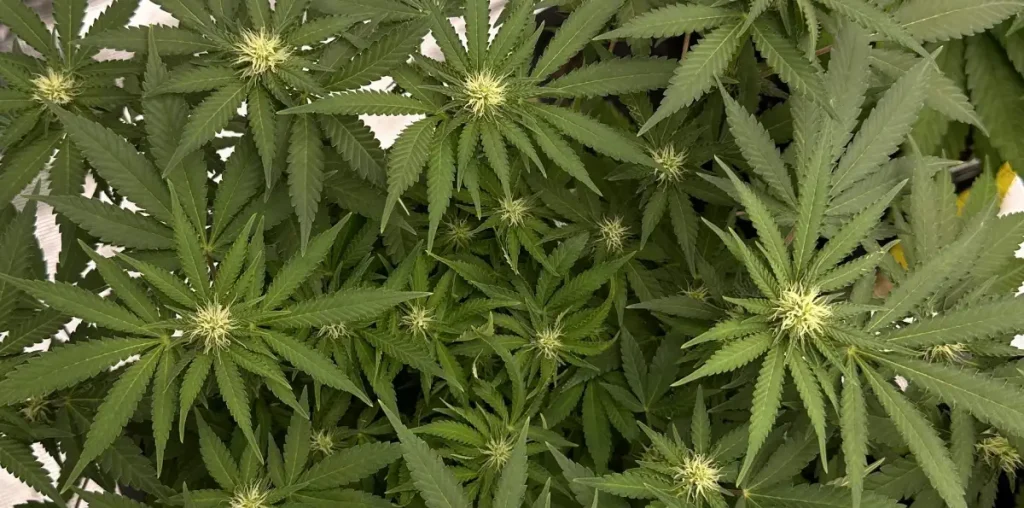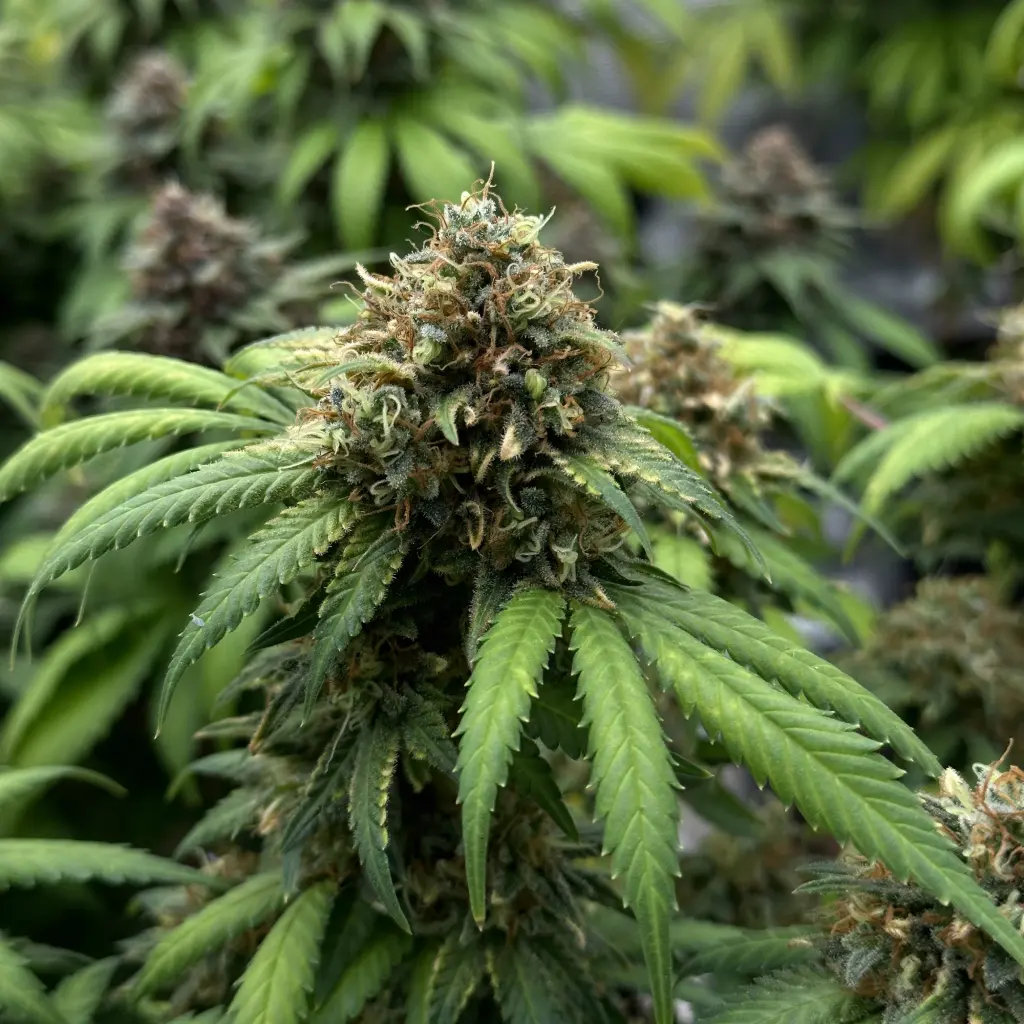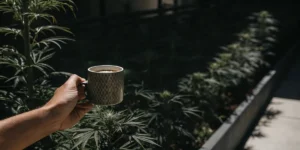Exceptional Genetics and Effects
The AMS strain, short for “Anti Mold Strain,” is a hybrid cannabis variety renowned for its exceptional resistance to mold and high humidity. This makes it an ideal choice for growers in challenging climates. AMS combines Swiss indica and sativa genetics, resulting in a robust plant that delivers balanced effects and a sweet, citrusy flavor profile.
With THC levels ranging from 15% to 19%, AMS offers a mild yet uplifting high, perfect for users seeking relaxation without being overwhelmed. Its resilience and adaptability make it a top choice for beginners and seasoned growers, consistently delivering reliable yields and premium-quality buds.
Environmental Requirements for Growing AMS Strain
AMS thrives in environments with moderate temperatures and carefully controlled humidity levels. During the vegetative stage, maintain temperatures between 70-85°F (21-29°C) and humidity levels of 50-70%. As the plant transitions to flowering, reduce humidity to 40-50% to enhance bud development and prevent mold.
Good air circulation is essential for promoting healthy growth and reducing the risk of mold. Indoors, use oscillating fans and exhaust systems to maintain airflow. Outdoors, AMS performs best in sunny, Mediterranean-like climates but also thrives in more humid regions due to its natural mold resistance.
Setting Up The Growing Cannabis Space
Indoor Cannabis Cultivation
When cultivating AMS indoors, a grow tent equipped with LED grow lights is ideal for optimizing light exposure and energy efficiency. Maintain a consistent light schedule of 18/6 during the vegetative stage and switch to 12/12 during flowering to stimulate bud production. Use high-quality soil or a hydroponic system with a pH range of 6.0-6.5 for soil and 5.5-6.0 for hydroponics. Regular pruning improves airflow and light penetration, while low-stress training (LST) maximizes yields. Ventilation systems, including exhaust fans and carbon filters, help regulate temperature and manage odors effectively.
Outdoor Cannabis Cultivation
Outdoors, AMS thrives in nutrient-rich, well-draining soil. Choose a location that receives at least 6-8 hours of direct sunlight daily and provide natural barriers or stakes for support. Its mold resistance allows it to flourish in humid climates, but monitoring soil moisture and weather conditions remains essential. Plant AMS after the last frost in spring to ensure stable temperatures throughout its growth cycle. Regularly inspect for pests and environmental stressors, and use organic fertilizers to boost growth. Outdoor plants often produce significantly larger harvests when provided ample care and space.
Propagation and Germination of AMS Strain
Start with high-quality seeds to ensure robust genetics. The paper towel method is a reliable germination technique: place seeds between moist paper towels in a warm, dark location. Within 24-72 hours, taproots should appear, signaling readiness for planting.
Transfer germinated seeds to small pots filled with light, aerated soil. Keep the medium moist but not waterlogged, and provide gentle light with temperatures between 75-80°F (24-27°C). As seedlings mature, transplant them into larger containers or directly into outdoor soil to promote root development.
Vegetative Phase of AMS Strain
During the vegetative stage, AMS exhibits rapid growth, developing strong stems and broad leaves. Provide a nutrient mix rich in nitrogen to support foliage development and maintain an 18/6 light schedule indoors. Outdoors, ensure plants receive ample sunlight and regular watering.
Prune and train plants to improve airflow and light penetration. Techniques like low-stress training (LST) and topping help control plant height and shape, maximizing yield potential. Regularly monitor for pests, nutrient deficiencies, or stress to ensure healthy development.
Flowering Phase of AMS Strain
AMS transitions to flowering after 8-10 weeks of vegetative growth. During this stage, reduce humidity levels and switch to bloom-specific nutrients high in phosphorus and potassium. The flowering phase typically lasts 8-9 weeks, during which buds become dense and aromatic. Monitor trichome development closely to determine the ideal harvest time. When trichomes turn milky white with a few amber hues, the buds are at peak potency. Maintain consistent airflow and inspect regularly for pests or mold to secure high-quality yields.
Cannabis Fertilization and Nutrition – AMS Strain
AMS requires stage-specific nutrition for optimal growth. During the vegetative phase, use nitrogen-rich fertilizers to promote vigorous leaf and stem growth. As the plant enters flowering, shift to nutrients rich in phosphorus and potassium to support bud production and resin development.
Incorporate organic supplements like bat guano, kelp, and compost tea to enhance flavor and terpene profiles. Avoid overfeeding to prevent nutrient burn, and flush the plants with plain water during the final two weeks before harvest to ensure smooth and flavorful buds.
Pest and Disease Control for Cannabis Growing
Prevention
Preventing pests and diseases is critical for a successful grow. Maintain a clean grow space and use sticky traps to monitor insect activity. Natural deterrents like neem oil and insecticidal soap are effective. Companion planting with pest-repelling herbs such as basil or marigold can further reduce infestation risks.
Corrective Actions
If pests or diseases arise, act swiftly to minimize damage. Beneficial insects like ladybugs or predatory mites can naturally manage infestations. For fungal issues, improve airflow and apply organic fungicides. Regular plant inspections ensure early detection and effective interventions.
Harvesting and Curing for Cannabis Growing
Harvest AMS when trichomes are predominantly milky with some amber hues, indicating peak potency. Use sterilized scissors to trim buds and hang them upside down in a dark, ventilated space with 45-55% humidity and temperatures around 65-70°F (18-21°C).
Once dried, cure the buds in airtight jars, opening them daily for the first week to release excess moisture. This curing process enhances the strain’s flavor, aroma, and potency, resulting in a premium-quality final product.
Is AMS Strain Indica or Sativa?
AMS is a balanced hybrid, featuring both indica and sativa traits. Its effects combine uplifting cerebral stimulation from sativas with calming body relaxation from indicas, making it suitable for use throughout the day or evening.
Advantages of Growing AMS Strain
AMS is celebrated for its resistance to mold, making it a reliable choice for growers in humid climates or those seeking low-maintenance plants. Its balanced effects, sweet flavor, and robust growth characteristics make it highly appealing to both cultivators and consumers.
The strain’s adaptability to various growing environments and its high yield potential further enhance its desirability. Whether grown indoors or outdoors, AMS consistently delivers exceptional results.
Disadvantages of Growing AMS Strain
Despite its many advantages, AMS requires precise environmental controls to thrive. Its nutrient needs can be demanding for beginners, and improper care may lead to lower yields or reduced quality.
The plant’s rapid growth necessitates frequent pruning and training to maintain shape and airflow. Regular monitoring and attention to detail are essential for maximizing its potential.
Problems in Cultivating AMS Strain
Common challenges when growing AMS include nutrient deficiencies, overwatering, and pest infestations. Maintaining a balanced watering schedule, using high-quality fertilizers, and conducting regular plant inspections can mitigate these issues. Training techniques like topping and low-stress training (LST) optimize light penetration and airflow, reducing the risk of mold and ensuring healthy development.
Advanced Pest Control for Cannabis Growing
For severe pest infestations, consider integrated pest management (IPM) strategies. Biological controls like Bacillus thuringiensis effectively target caterpillars, while predatory insects such as ladybugs manage smaller pests. A clean and organized grow space minimizes the likelihood of infestations.
Similar Strains
Cheese
Cheese is a mold-resistant strain that thrives in both indoor and outdoor environments. Known for its unique combination of skunky and sweet cheese flavors, this strain delivers a balanced high that relaxes the body while uplifting the mind. With a flowering period of 7-9 weeks, Cheese is a favorite among growers for its ease of cultivation and high yields. Its resilience to environmental stress makes it an excellent alternative to AMS for growers in humid climates.
Super Silver Haze
Super Silver Haze is a sativa-dominant hybrid renowned for its energetic and euphoric effects. This strain combines Haze, Northern Lights, and Skunk genetics, resulting in a citrusy and spicy flavor profile. It flourishes in controlled indoor setups but can also thrive outdoors in warm climates. With a flowering period of 10-12 weeks, it rewards growers with dense, resin-coated buds. Its adaptability and high THC levels make it a top choice for those seeking a vigorous, uplifting strain.
Critical Kush
Critical Kush is an indica-dominant hybrid prized for its massive yields and robust growth. This strain features a sweet, earthy aroma with hints of citrus, providing deeply relaxing effects ideal for evening use. Critical Kush is easy to grow, making it suitable for beginners and experienced cultivators alike. Its natural resistance to pests and diseases, combined with a short flowering time of 7-8 weeks, ensures consistent, high-quality harvests.

Week-by-Week Growth Plan for AMS Strain
Week 1-2: Germination and Seedling Stage
During the first two weeks, focus on germination and seedling development. Maintain a temperature range of 75-80°F (24-27°C) and high humidity levels of 70-80%. Use gentle lighting, such as CFL or LED lights, to provide adequate energy without stressing the young plants. Keep the soil consistently moist but avoid overwatering to prevent root rot. By the end of this stage, seedlings should have developed their first set of true leaves.
Week 3-5: Vegetative Stage
In weeks 3-5, AMS enters the vegetative phase. Increase light intensity and maintain an 18/6 light cycle for indoor grows. Provide nitrogen-rich nutrients to support vigorous foliage and stem development. Monitor and adjust the pH level to remain between 6.0 and 6.5 for soil and 5.5 to 6.0 for hydroponics. Begin implementing low-stress training (LST) or topping techniques to optimize light penetration and airflow. Ensure plants receive regular watering and inspect for any signs of pests or nutrient deficiencies.
Week 6-10: Flowering Stage
The flowering phase begins around week 6. Switch to a 12/12 light schedule indoors to trigger bud formation. Feed plants with bloom-specific nutrients high in phosphorus and potassium to support bud development. Lower humidity levels to 40-50% to prevent mold, and maintain temperatures between 68-78°F (20-26°C). Monitor trichome development closely; milky white trichomes with some amber hues indicate peak potency. Regularly check for pests or diseases to ensure a healthy harvest.
Week 11-12: Harvesting and Curing
In the final weeks, trichomes should reach full maturity. Use sterilized tools to harvest the buds and trim excess foliage. Hang the buds upside down in a dark, well-ventilated space with 45-55% humidity and temperatures around 65-70°F (18-21°C) for drying. After 7-10 days, transfer dried buds to airtight jars for curing, opening them daily for the first week to release moisture. This process enhances the flavor, aroma, and potency of the final product.
FAQs About AMS Strain
What Makes AMS Strain Resistant to Mold?
AMS strain is specifically bred with Swiss genetics to thrive in high-humidity environments. Its dense structure and natural resilience reduce the likelihood of mold formation, making it an ideal choice for growers in challenging climates. Regular pruning and maintaining proper airflow further enhance its resistance.
How Long Does It Take to Grow AMS Strain?
AMS has a relatively short growth cycle. From germination to harvest, the strain typically takes 12-14 weeks to complete. The vegetative stage lasts around 4-6 weeks, while the flowering stage requires an additional 8-9 weeks. Following a proper growth plan ensures optimal yields and potency.
What Are the Effects of AMS Strain?
AMS delivers a balanced combination of cerebral and physical effects. Its sativa lineage provides an uplifting, euphoric high, while its indica genetics offer calming and relaxing sensations. This makes AMS suitable for both daytime and evening use, appealing to recreational and medicinal users alike.





